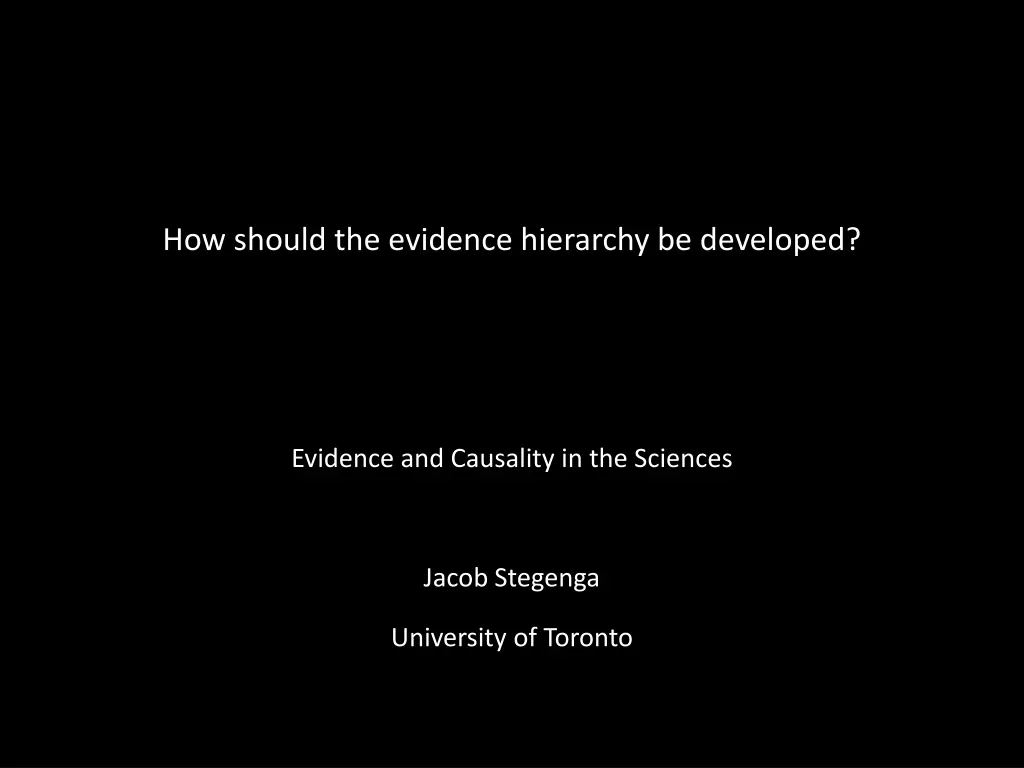
Developing Evidence Hierarchy in Sciences
Explore the arguments against having an evidence hierarchy, emphasizing the limitations of hierarchies in utilizing diverse evidence types and assessing quality. Learn about alternative quality assessment tools like Quality Assessment Tools (QATs) and specific scales such as Jadad and Chalmers QATs.
Uploaded on | 1 Views
Download Presentation

Please find below an Image/Link to download the presentation.
The content on the website is provided AS IS for your information and personal use only. It may not be sold, licensed, or shared on other websites without obtaining consent from the author. If you encounter any issues during the download, it is possible that the publisher has removed the file from their server.
You are allowed to download the files provided on this website for personal or commercial use, subject to the condition that they are used lawfully. All files are the property of their respective owners.
The content on the website is provided AS IS for your information and personal use only. It may not be sold, licensed, or shared on other websites without obtaining consent from the author.
E N D
Presentation Transcript
How should the evidence hierarchy be developed? Evidence and Causality in the Sciences Jacob Stegenga University of Toronto
There should be no evidence hierarchy. Four arguments (in five minutes)
1 Hierarchies are poor methods of using diverse evidence. Russo and Williamson (2007), Illari (2011), La Caze (2011)
2 Different types of hypotheses need different types of evidence. This intervention will work for us. (Cartwright 2007) This intervention is harmful. (Osimani, 3:00 p.m.)
3 Trouble at the top. Randomization does not guarantee homogeneity. (Worrall 2002) Meta-analysis is not all it s made out to be. (Stegenga 2011) Many RCTs are methodologically flawed. (Hartling 2011, Moher 2008) Many RCTs produce results which are simply false. (Ioannidis 2005)
4 Hierarchies are crude quality assessment tools. Hierarchies are constrained to ordinal rankings based on few parameters. Better to evaluate evidence with richer scales based on more parameters.
Quality assessment tools (QATs) A scale or checklist for properties of medical studies Dozens now in use to assess medical evidence As weighting factor in meta-analysis As inclusion criterion for systematic reviews To test relation between quality and other properties of studies
Jadad QAT 1. Was the study described as randomized? (1 point) method of randomization (1 point) 2. Was the study described as double blind? (1 point) method of blinding (1 point) 3. Was there a description of withdrawals and dropouts? (1 point) 5 points total
Chalmers QAT 30 items in four forms i. Descriptive summary ii. Study protocol (weight: 0.6) iii. Statistical analysis (weight: 0.3) iv. Presentation of results (weight: 0.1)
Six QATs Number of Items 3 Weight of Randomization 40.0 Weight of Blinding 40.0 Weight of Withdrawal 20.0 Scale Jadad (1996) Chalmers (1981) 30 13.0 26.0 7.0 Cho & Bero (1994) 24 14.3 8.2 8.2 Reisch (1989) 34 5.9 5.9 2.9 Spitzer (1990) 32 3.1 3.1 9.4 Linde (1997) 7 28.6 28.6 28.6
QATs: buyer beware. QATs have low inter-rater reliability and low inter-tool reliability. QATs lack a focused theoretical basis (J ni et al. 1999)
We can do better. Structural metaphors evidence pyramid (Cartwright) evidence network (Bluhm) evidence matrix (Borgerson) Principles principal of total evidence in medicine (Leuridan) Russo-Williamson thesis Tools QATs
Thank you for your attention. Jacob Stegenga University of Toronto
